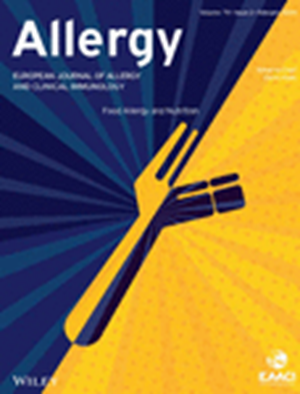对室内尘螨过敏的成人皮下过敏原免疫治疗:一项3期随机对照试验。
IF 12
1区 医学
Q1 ALLERGY
引用次数: 0
摘要
皮下过敏原免疫疗法(SCIT)作为一种安全有效的治疗方法有着悠久的历史。然而,为了满足欧洲药品管理局对持续市场授权的监管要求,其有效性和安全性必须在关键的III期试验中得到证实。基于一项成功的II期剂量研究,目的是在一项随机对照试验中确认皮下尘螨(HDM)制剂的安全性和有效性,使用比当前维持剂量更高的最佳剂量。方法767名受试者按1:1的比例随机分为5万AUeq/mL剂量的scit产品或安慰剂治疗1年。其中,682名受试者完成了研究。主要终点采用症状和药物联合评分(CSMS(n))进行评估,该评分侧重于由欧洲过敏和临床免疫学学会(EAACI)指定的鼻腔症状。结果主要终点显示,与安慰剂治疗相比,积极治疗的平均CSMS(n)的有利变化趋势(p = 0.0767)为-0.12 (95% CI, -0.3至0)。然而,0.12分的治疗效果没有达到预先规定的最小临床相关差异0.25分。在767名随机患者中,539名患者有轻度症状,228名患者有中度至重度HDM过敏症状,平均基线每日症状评分(dSS(n))至少为2。对临床数据的后期分析,重点关注这一亚组有中度至重度症状的患者,显示了主要终点的显著治疗效果,临床意义降低了-0.39点(95% CI, -0.64至-0.13;p = 0.0031),从而超过了预先规定的最小差异0.25点。与轻度症状组相比,中度至重度症状组未观察到额外的安全性问题。结论5万AUeq/mL剂量的scit产品治疗是安全且耐受性良好的。主要结果没有达到,在活性组和安慰剂组之间没有观察到显著差异。一个可能的解释可能是主要纳入了症状轻微的犀牛结膜炎患者(767名随机受试者中的539名)。然而,事后分析表明,SCIT在中度至重度疾病患者亚组中是有效的,这表明纳入了很大一部分只有轻度症状的hdm诱导的鼻结膜炎患者可能影响了整体研究结果。因此,再次确认疗效需要足够的基线症状严重程度,特别是在HDM过敏患者中。本文章由计算机程序翻译,如有差异,请以英文原文为准。
Subcutaneous Allergen Immunotherapy in Adults Allergic to House Dust Mites: A Phase 3 Randomized Controlled Trial.
BACKGROUND
Subcutaneous allergen immunotherapy (SCIT) has a longstanding history as a safe and effective treatment. Nevertheless, to meet the European Medicines Agency's regulatory requirements for continued market authorization, its efficacy and safety must be confirmed in a pivotal Phase III trial.
OBJECTIVE
Based on a successful Phase II dose-finding study, the aim was to confirm the safety and efficacy of a subcutaneous house dust mites (HDM) preparation in a randomized controlled trial using an optimal higher dose than the current maintenance dose.
METHOD
Seven hundred sixty-seven subjects were randomized in a 1:1 ratio to 1-year treatment with SCIT-product at a dose of 50,000 AUeq/mL or placebo. Out of these, 682 subjects completed the study. The primary endpoint was assessed using the combined symptom and medication score (CSMS(n)), which focuses on nasal symptoms, as specified by the European Academy of Allergy and Clinical Immunology (EAACI).
RESULTS
The primary endpoint showed a trend (p = 0.0767) with a mean treatment effect of -0.12 (95% CI, -0.3 to 0) toward a favorable change in mean CSMS(n) for active compared to placebo treatment. This treatment effect of 0.12 points did however not meet the prespecified minimal clinically relevant difference of 0.25 points. Among the 767 randomized patients, 539 had mild symptoms and 228 patients had moderate to severe HDM allergic symptoms, defined by a mean baseline daily symptom score (dSS(n)) of at least 2. Post hoc analysis of the clinical data, focusing on this subgroup of patients with moderate to severe symptoms, revealed a significant treatment effect for the primary endpoint, with a clinically meaningful reduction of -0.39 points (95% CI, -0.64 to -0.13; p = 0.0031) thereby surpassing the minimal prespecified difference of 0.25 points. No additional safety concerns were observed in the moderate to severe symptom group compared with the minor symptom group.
CONCLUSION
Treatment with the tested SCIT-product at a dose of 50,000 AUeq/mL was safe and well tolerated. The primary outcome was not met, with no significant difference observed between the active and placebo groups. A likely explanation might be the inclusion of mainly patients with mild symptoms of rhino conjunctivitis (539 of in total 767 randomized subjects). Post hoc analysis, however, indicated that SCIT was effective in the subgroup of patients with moderate to severe disease, suggesting that the overall study outcome may have been influenced by the inclusion of a large proportion of patients with only mild symptoms of HDM-induced rhino-conjunctivitis. As a consequence, reconfirming efficacy requires adequate baseline symptom severity, especially in HDM allergic patients.
求助全文
通过发布文献求助,成功后即可免费获取论文全文。
去求助
来源期刊

Allergy
医学-过敏
CiteScore
26.10
自引率
9.70%
发文量
393
审稿时长
2 months
期刊介绍:
Allergy is an international and multidisciplinary journal that aims to advance, impact, and communicate all aspects of the discipline of Allergy/Immunology. It publishes original articles, reviews, position papers, guidelines, editorials, news and commentaries, letters to the editors, and correspondences. The journal accepts articles based on their scientific merit and quality.
Allergy seeks to maintain contact between basic and clinical Allergy/Immunology and encourages contributions from contributors and readers from all countries. In addition to its publication, Allergy also provides abstracting and indexing information. Some of the databases that include Allergy abstracts are Abstracts on Hygiene & Communicable Disease, Academic Search Alumni Edition, AgBiotech News & Information, AGRICOLA Database, Biological Abstracts, PubMed Dietary Supplement Subset, and Global Health, among others.
 求助内容:
求助内容: 应助结果提醒方式:
应助结果提醒方式:


